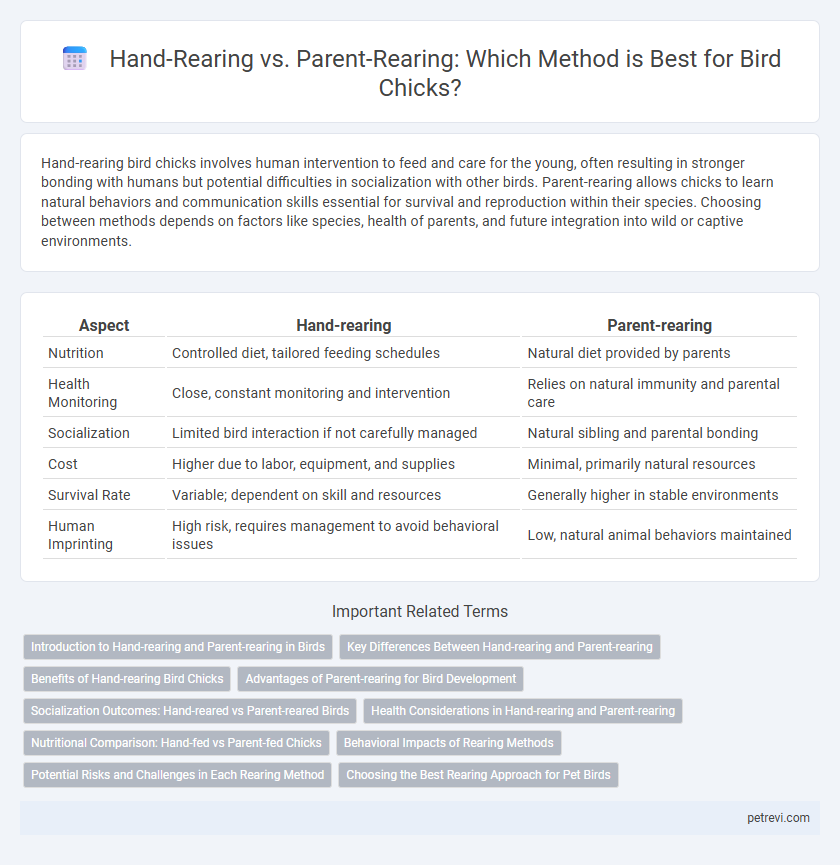Hand-rearing bird chicks involves human intervention to feed and care for the young, often resulting in stronger bonding with humans but potential difficulties in socialization with other birds. Parent-rearing allows chicks to learn natural behaviors and communication skills essential for survival and reproduction within their species. Choosing between methods depends on factors like species, health of parents, and future integration into wild or captive environments.
Table of Comparison
| Aspect | Hand-rearing | Parent-rearing |
|---|---|---|
| Nutrition | Controlled diet, tailored feeding schedules | Natural diet provided by parents |
| Health Monitoring | Close, constant monitoring and intervention | Relies on natural immunity and parental care |
| Socialization | Limited bird interaction if not carefully managed | Natural sibling and parental bonding |
| Cost | Higher due to labor, equipment, and supplies | Minimal, primarily natural resources |
| Survival Rate | Variable; dependent on skill and resources | Generally higher in stable environments |
| Human Imprinting | High risk, requires management to avoid behavioral issues | Low, natural animal behaviors maintained |
Introduction to Hand-rearing and Parent-rearing in Birds
Hand-rearing bird chicks involves human intervention feeding and caring for hatchlings, ensuring their survival when parents are unable or absent. Parent-rearing allows chicks to develop naturally through species-specific behaviors, social learning, and nourishment provided by the adult birds. Comparing these methods highlights crucial differences in imprinting, health risks, and long-term behavioral development.
Key Differences Between Hand-rearing and Parent-rearing
Hand-rearing bird chicks involves human caretakers feeding and nurturing the birds directly, ensuring precise control over diet, health, and socialization, while parent-rearing relies on the natural instincts of adult birds to feed and protect their offspring. Hand-rearing often results in stronger human imprinting, which can affect a bird's behavior and tameness, whereas parent-reared chicks typically develop natural survival and social skills. The choice between these methods depends on species-specific needs, the condition of the parents, and conservation or breeding goals.
Benefits of Hand-rearing Bird Chicks
Hand-rearing bird chicks ensures precise control over nutrition and health, significantly reducing mortality rates during the vulnerable early stages. It promotes strong human imprinting, resulting in more sociable and easily trainable birds, which is especially beneficial in aviculture and conservation programs. Early intervention through hand-rearing also allows for timely medical care, enhancing the overall survival and development of endangered or delicate bird species.
Advantages of Parent-rearing for Bird Development
Parent-rearing in bird chicks fosters natural social behaviors and species-specific skills essential for survival, such as foraging and predator awareness. Chicks raised by their parents receive appropriate nutrition and environmental stimulation, promoting optimal growth and immune system development. This method also enhances long-term psychological well-being and adaptability compared to hand-rearing.
Socialization Outcomes: Hand-reared vs Parent-reared Birds
Hand-reared bird chicks often exhibit stronger human bonding but may struggle with species-specific social behaviors compared to parent-reared birds, which naturally develop complex communication and social skills within their flock. Parent-reared birds typically show higher success in mate selection and territorial behaviors due to early exposure to natural social cues. Studies on parrots and raptors indicate that socialization outcomes heavily influence long-term adaptability and psychological well-being in avian species.
Health Considerations in Hand-rearing and Parent-rearing
Hand-rearing bird chicks requires meticulous hygiene and controlled feeding schedules to prevent nutritional deficiencies and reduce the risk of bacterial infections and crop impactions. Parent-rearing allows chicks to receive natural immunity through the parents' feeding regurgitation, as well as behavioral learning critical for species-specific health and social development. Monitoring chick growth rates and immune responses in both methods highlights that while hand-rearing demands intensive veterinary oversight, parent-rearing offers a more balanced exposure to natural microbial flora promoting robust health.
Nutritional Comparison: Hand-fed vs Parent-fed Chicks
Hand-reared bird chicks often receive precisely formulated diets rich in essential nutrients tailored to their species-specific growth requirements, resulting in controlled nutritional intake. Parent-fed chicks benefit from natural feeding behaviors where adult birds provide regurgitated food, offering variable nutrient profiles influenced by parental diet and foraging success. Comparative studies indicate that hand-reared chicks may achieve faster growth rates but could lack certain immune factors present in parent-fed nourishment, impacting long-term health outcomes.
Behavioral Impacts of Rearing Methods
Hand-rearing bird chicks often leads to increased human imprinting, which can alter natural behaviors such as foraging, social interaction, and mate selection, potentially reducing survival skills in the wild. Parent-rearing supports the development of species-typical behaviors through natural social learning, promoting better integration into wild populations and improved reproductive success. Behavioral differences stemming from rearing methods are critical for conservation and rehabilitation programs aiming to release birds into their natural habitats.
Potential Risks and Challenges in Each Rearing Method
Hand-rearing bird chicks risks improper imprinting and increased vulnerability to diseases due to human interaction, while parent-rearing may lead to higher chick mortality from neglect or sibling competition. Hand-reared birds often face behavioral issues, such as poor socialization and dependency on humans, impacting their survival and reproduction in the wild. Parent-rearing challenges include inconsistent feeding and exposure to parasites, which can hinder chick development and reduce overall survival rates.
Choosing the Best Rearing Approach for Pet Birds
Hand-rearing bird chicks allows for early socialization and tameness, essential for companion birds like parrots, while parent-rearing supports natural development of species-specific behaviors and immune strength. Evaluating the species, the caretakers' experience, and the bird's long-term welfare is crucial in selecting the best rearing approach for pet birds. Prioritizing a balance between social bonding and behavioral authenticity leads to healthier, well-adjusted birds.
Hand-rearing vs Parent-rearing for Bird chicks Infographic

 petrevi.com
petrevi.com